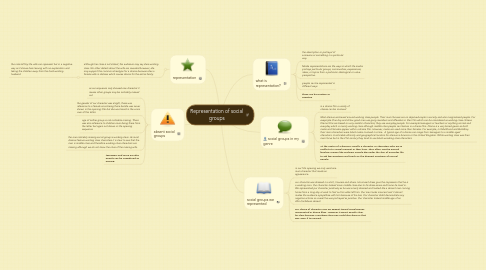Representation of social groups
by rochelle cassell

1. representation
1.1. although her class is not stated, the audience may say shes working class. No other details about the wife are revealed however, she may support the common streotype for a drama because shes a female wife in distress which causes drama for the entire family.
1.1.1. the note left by the wife can represent her in a negative way as it shows here leaving with no explanation and taking the children away form the hard-working husband
2. absent social groups
2.1. as our sequence only showed one character it means other groups may be noticably missed out
2.2. the gender of our character was alright, there was reference to a female once being there butshe was never shown in the opening title but she was heard in the voice over of the letter.
2.3. age of nother group is not noticable missing. There was also reference to children once being there from the letter but again not shown in the opening sequence.
2.4. the one noticably missing social group is working class. As most dramas feature working class characters it is clear to see that the man is middle class and therefore working class characters are missing although we do not know the class of the missing wife.
2.5. teenagers and more evryday people can be considered as missing.
3. what is representation?
3.1. the description or portrayal of someone or something in a particular way.
3.2. Media representations are the ways in which the media portrays particular groups, communities, experiences, ideas, or topics from a particular ideological or value perspective.
3.3. people can be represented in different ways
3.4. these can be positive or negative
4. social groups in my genre
4.1. in a drama film a variety of classes can be involved
4.2. Most dramas are based around working class people. Their main focuses are on deprived eople in society and also marginalised people. For exapmple One day and A few good men use gang members and offenders in their film which can be considered as working class citizens. Drama films are based on very realistic characters; they use everyday people. For example teenagers or teachers or anything normal and everyday which is mainly working class although middle class people can feature in a drama film. Drama is a very broad genre so both males and females appear within a drama film. However, males are used more than females. For example, in Kidulthood and Bulletboy their main characters were black males involved in crime. A typical age of a drama can range from teenagers to a middle aged characters. A noticable ethnicity and geographical location for dramas is America or the United Kingdom. White working class was their main focus but in the 21st century they tend to use black woorking class characters.
4.3. At the center of a drama is usually a character or characters who are in conflict at a crucial moment in their lives. They often revolve around families; movies like Ordinary People dig under the skin of everyday life to ask big questions and touch on the deepest emotions of normal people.
5. social groups we represented
5.1. in our film opening we only used one main character that made an appearance.
5.2. our character was dressed in a shirt, trousers and shoes. His smaart dress give the impression that he is a working man. Our character looked more middle class due to his dress sense and home he lived in. We represented pur character positively as he was smarly dressed and looked like a decent man coming home from a long day at work to find out his wifes left him. Our man looks innocent and it almost makes the audience sympathise with him because of his loss. Our character didnt demonstrate any negative actions so overall he was portrayed as positive. Our character looked middle age of an Afro-Caribbean decent.
5.3. our choice of character may go against typical social groups represented in drama films. However it wasnt exactly clear his class because a working class man could also dress in that way even if tis unusual.


